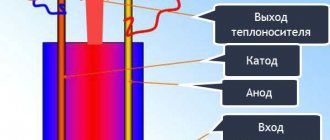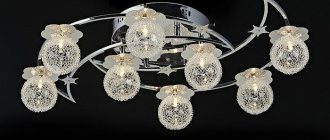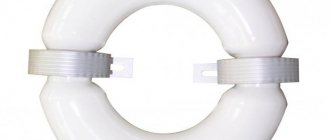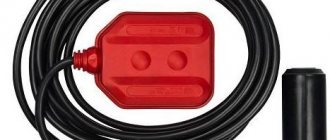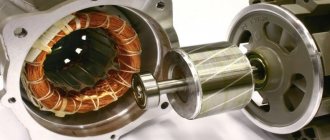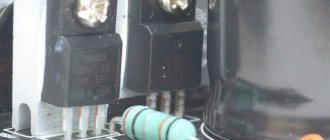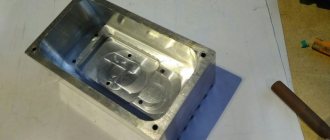The principle of heating materials by induced high-frequency currents has long been used in industry. The method can be used in everyday life to heat water, including for heating a house, since energy transfer occurs more efficiently and with fewer losses. Let's look at what an induction heater is, how it works, what pros and cons it has, and what are the features of making it yourself.
Induction type water heating unit Source by.kotel-electr.ru
Induction heating - what is it, application
Currently, the industry widely uses the method of non-contact heating of workpieces before performing various types of operations - melting, welding, soldering, forging, etc. Its efficiency is so high that it is quickly replacing traditional heating methods. Moreover, due to the peculiarities of energy transfer - without the use of a conductor - losses are minimal, and therefore the method has a high economic indicator.
Induction heating is an increase in the temperature of objects made of electrically conductive materials through the action of an alternating magnetic field in their structure. The technological essence of the procedure is as follows:
- The object that needs to be heated is placed inside an inductor - a conductor twisted in the form of a spiral.
- Next, alternating currents of high strength and different frequencies are sent to the inductor through a special generator.
- As a result, the conductor begins to emit an alternating magnetic field.
- An electrically conductive object is penetrated by this field, as a result of which induced currents arise in it.
- Under the influence of eddy currents, the temperature of the material increases.
The simplest induction heating device Source ytimg.com
This “inductor-object” circuit is essentially a transformer without a core. In it, the inductor is the primary winding, the object is the short-circuited secondary. The magnetic field flows are closed between them through the air. In powerful industrial installations, the inductor conductor itself can become very hot, so to ensure safety, a cooling system is connected to it.
The principle of induction heating is widely used in a wide variety of fields:
- Non-contact welding, melting and soldering of ultra-high purity.
- Heat treatment and bending of elements and assemblies in the automotive industry.
- Creation of experimental samples of alloys.
- Jewelry making.
- Hardening of products on the surface.
- Heat treatment of small-sized parts that are not accessible to plasma and arc.
- Heat treatment and hardening of elements of complex shapes.
- Disinfection of devices and instruments in medicine.
Instantaneous water heater is one of the most commonly used applications of induction heating in the home Source equipmaster.ru
On a note! The non-contact heating method has also found wide application in the manufacture of household heating devices, especially for water. However, in price, such models are significantly superior to traditional analogues operating on heating elements. Therefore, with sufficient experience, you can make them yourself.
Operating principle of the heater
The mechanism for generating heat in household electrical appliances of this type is based on the same law on which industrial installations operate. However, the scheme of their work has its own characteristics. First of all, they concern the device. Thus, a household induction instantaneous water heater consists of the following main elements:
- An inductor is a coil of copper wire. When a current passes through it, a magnetic field is formed, under the influence of which the electrically conductive material of the heater is heated.
- A generator is a converter of stable household current into a high-frequency flow required in terms of power.
See also: Catalog of companies that specialize in engineering systems (heating, water supply, sewerage and others) and related work
- The heating element is a metal pipe through which a water flow is passed to produce heating. The heater simultaneously functions as a cooler for the inductor, thereby providing it with stable operating characteristics and durability.
The generator converts the current from normal to high-frequency and supplies it to the coil. The wire winding produces a magnetic field. The tube heater located inside it heats up and transfers heat to the water flow passing through it. Due to the absence of direct contact during the transition from one type of energy to another, losses are minimal. The efficiency of such electric heaters reaches 98%.
Reference! An induction boiler works according to a similar scheme discussed above, which is an economical, efficient and durable heater for the home. Only instead of a tube, a heat exchange circuit is placed in the inductor, passing through which a special coolant is heated and distributed over all radiators of the living area.
Design and principle of operation of an induction boiler for heating Source oboiman.ru
Installation of an induction boiler and its control system
Installation of such boilers is only possible in a closed heating system. This requires an expansion tank and a pump for forced circulation of the coolant.
According to the instructions, the induction boiler is positioned strictly vertically. After this, the return pipe of the heating circuit is connected to the lower inlet pipe. The outlet is located at the top of the device (side or top). The supply pipeline is looped onto it.
The weight of the mounted boiler is quite serious, so special attention must be paid to the fastenings. They must be very reliable, taking into account the fact that when the boiler is operating, its weight will increase significantly due to the coolant entering inside. The lateral distance from the boiler to surrounding objects and walls is 300 mm. The distance to the floor and ceiling is 800 mm and no less. An important and mandatory condition for installing such boilers is their grounding. It is possible to use both metal and metal-plastic pipes with it.
A group of safety devices is built next to the outlet pipe: a blast valve, a pressure gauge, an air vent. The expansion tank is installed at a convenient location in the return pipe of the system. Shut-off valves are mainly installed after the safety group.
Installation of the entire control system, as well as the boiler itself, must be carried out in accordance with the existing rules and regulations of the Electrical Installation Code, diagrams and conditions contained in the technical data sheet included in the kit.
Connection diagram of an induction boiler to the heating system
Advantages and disadvantages
The advantages of a household water heater of this type are as follows:
- Long service life. The average warranty period for most manufacturers is 30 years. At the same time, the installation does not require serious maintenance and repair with the replacement of main elements throughout the entire period of operation. Preventative cleaning is carried out no more than once every 7-9 years.
- Economical energy consumption. To produce the same amount of heat, in comparison with varieties operating on traditional heating elements, 30-40% less energy is spent.
- No scale. The specific mechanism of operation of the device eliminates the formation of scale on the working elements of the installation. In addition, when the device is turned on, it vibrates slightly, which is also a good protective factor against the build-up of various types of deposits on its internal parts in contact with water.
- Minimal risk of leaks. Non-contact heating technology eliminates the factors of destruction - when metal elements quickly rust under the influence of heat and dampness.
An induction water heater is reliable, durable and economical Source rusolymp.ru
Replacing the heating element
The service life of heating elements depends on the quality of the coolant. As “comparators” assure, this is only 1000 hours of work, if you do not take action and soften hard water. Well, if they softened it, then about 5000.
When using this data, the heating and water supply systems are confused.
In closed heating systems there are not as many impurities as in water supply. In most cases, water softening is simply not required here.
This may only apply to domestic hot water or central heating. There, the boiler room operator is unable to track water leaks.
If we are talking purely about your home, where everything is assembled and connected without leaks or holes, then no constant water preparation is required. Of course, the water will contain some elements, but once they are poured into the heating system, they will react once or more; they will have nowhere to come from.
Induction ones supposedly have low operating costs due to the very rare replacement of components. In fact, this is in high-quality PETN samples; the elements change extremely rarely, as mentioned above.
But if you need to change something in the induction room, you will think twice before doing it. Everything there is sealed in a sealed flask and you can’t get inside without physically cutting it.
Features of self-production
In order to make an induction heater, you must have experience in electrical work and assembling homemade electrical appliances, as well as skills in processing metal and other materials and be able to install wiring. Therefore, in their absence, it is better to entrust such work to professionals. In this case, the general algorithm for manufacturing the device consists of the following sequential stages:
- Making a heater. As a rule, a section of thick-walled metal pipe with adapters at the ends is used, enclosed in a heat-resistant plastic tube of a larger diameter.
Video description
Video example of making an induction heater:
- Creation of an inductor. An insulated copper wire with a cross-section of about 1-1.5 mm2 is tightly wound around the tube. The number of turns must be at least 90.
- Selecting a suitable alternator. The simplest and most affordable way is to use an inverter from an appropriate welding unit.
- Connecting the heater with the inductor to the water supply or heating pipe.
- Connecting the inductor to the network. The contact wires from the coil are connected to the positive contacts of the inverter.
- Power supply. Rectifier diodes are installed at the terminals. Without them, the voltage of the supplied current will be supplied rectified, and the coil will function as an electromagnet rather than an inductor.
- Turning on and checking the operation of the device.
Note! A self-made heater, unlike factory-made analogues, is not equipped with a protection and control system. Therefore, before turning it on, you must make sure that the heating element is filled with water.
Briefly about the main thing
Induction heating is based on the ability of an alternating magnetic field to increase the temperature of objects made of electrically conductive materials. Heating is carried out in a non-contact manner and is characterized by high performance and low energy losses. For this reason, the method is widely used in various fields - melting, welding, soldering of metals, heat treatment of components and elements in production, disinfection of instruments in medicine.
The same principle applies to the operation of a domestic water heater. The heating element through which the water passes is placed in an inductor coil. When a high-frequency current is applied, an alternating magnetic field is generated, heating the metal heater. Among the main advantages of such devices are:
- Durability.
- Economy.
- No scale.
- Leak-free operation.
- Natural convection.
Disadvantages are associated with the release of heat into the surrounding space, the need for a stable power supply, constant monitoring of performance characteristics, operating noise and harmful radiation. When manufacturing the device, you must follow the instructions and have sufficient experience.
Safety Tips
Installations of this type are widely used not only for space heating, but also for smelting operations. The main problem with home-made induction devices is the lack of components that provide temperature and pressure control and explosion protection. Therefore, when operating such units, care and caution must be exercised.
Before starting the induction boiler, it is necessary to fill the system with coolant
Before starting the boiler, check that the cavity is filled with coolant. A case made of polymers will begin to melt without regular cooling with liquid. This entails deformation changes and complete failure of the installation. Also dangerous can be the fall of hot metal from the melting body. In the event of such an incident, it will be necessary to replace a number of installation components.
The device is connected to electricity through a separate wire, which is led from the switchboard. The contacts must be covered with insulating material. If the design involves a welding machine, its inverter must be grounded. The wire used for this operation should be 4-6 mm in diameter. To prevent excessive heating of the installation in the absence of water, it is advisable to install an excess pressure valve in the inlet.
